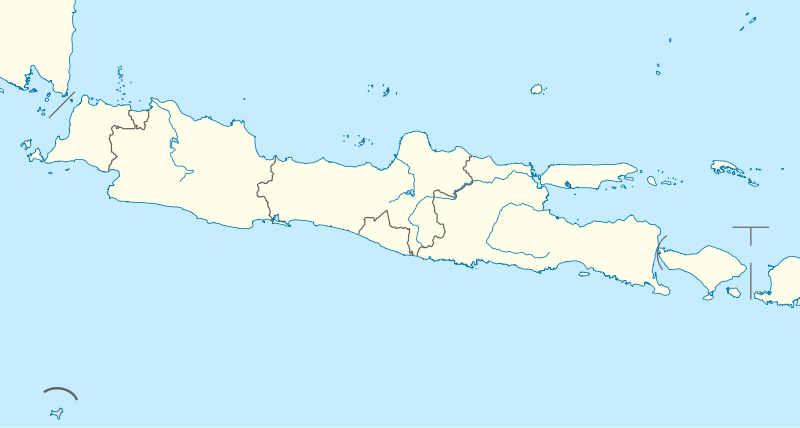Cimahi
Cimahi (Indonesian pronunciation: [tʃimahi]) is a city located west of Bandung, West Java, Indonesia in the Bandung Metropolitan Area. The city is a major textile producer, and is home to several military training centers.[2]
Cimahi ᮎᮤᮙᮠᮤ | |
|---|---|
 Coat of arms | |
| Motto(s): Saluyu Ngawangun Jati Mandiri | |
 Location within West Java | |
| Coordinates: 6°52′16″S 107°33′17″E | |
| Country | |
| Province | |
| Government | |
| • Mayor | Ajay Muhammad Priyatna[1] |
| • Vice Mayor | Ngatiyana[1] |
| Area | |
| • Total | 40.2 km2 (15,4 sq mi) |
| Elevation | 685 m (2,247 ft) |
| Population (2014) | |
| • Total | 561,386 |
| • Density | 13,964/km2 (36,453/sq mi) |
| Time zone | UTC+7 (Indonesia Western Time) |
| Area code | +(62) 22 |
| Website | cimahikota.go.id |
Geography

Cimahi, located 180 km south east of Jakarta, is situated between Bandung and West Bandung Regency.[3] Cimahi comprises three districts, which in turn are grouped into fifteen villages. Its lowest elevation is 685 metres (2,247 ft) above sea level and directs to Citarum River. Its highest elevation is 1,040 metres (3,410 ft) above sea level, which is part of the slope of mount Tangkuban Perahu and Burangrang. The Cimahi river flows through the city and Cimahi also has two Springs, named Cikuda and Cisontok.[4]
History
The name Cimahi was taken from the Cimahi river that flows through the city. The word originated from the Sundanese language and literally means "enough water". Residents of Cimahi get their water supply from the river.[5]
Cimahi's prominence increased in 1811, when Governor-General Herman Willem Daendels constructed the Great Post Road. A checkpoint, known as Loji, was built in Cimahi Square. Between 1874–1893, the Cimahi rail station and a railroad connecting Bandung and Cianjur was built. The building of military training centers and other military buildings was started in 1886. Cimahi was granted district status in 1935. In 1975, Cimahi became the first administrative city in West Java and the third in Indonesia. Cimahi was then granted full city status in 2001.[6]
Administration
The city administration is divided into three districts and fifteen villages. A mayor leads the city administration. Cimahi's three districts are listed below:[4]
Tourism
Cimahi has various tourist hotspots, such as Alam Wisata Cimahi, Pandiga Recreation Sport, Rumah Pajang, Lembur Batik and Kampung Adat Cirendeu. According to the local tourist office, these offer distinctive experiences in nature, cuisine, handicrafts and traditional community.[7] Additionally, there are some buildings of historical interest, such as Dustira Hospital, Ereveld Cemetery, Military Prison and Sudirman Building.[8]
Notable people
- Amirmachmud, former military general and politician[9]
- Jack Jersey Music producer, composer, lyricist, arranger and singer.
- Anthony Sinisuka Ginting, Indonesian badminton player.
- Sule, comedian[10]
- Maria Hertogh, born in Tjimahi and the person at the centre of the Maria Hertogh riots
Sister cities

References
- Post, Pikiran Rakyat. "Ajay-Ngatiana Formally Inaugurated as Cimahi's Mayor-Deputy Mayor (Indonesian)".
- "PENGANTAR DARI WALIKOTA CIMAHI" (in Indonesian). Archived from the original on 4 March 2016. Retrieved 16 September 2015.
- "GEOGRAFI" (in Indonesian). Archived from the original on 4 March 2016. Retrieved 16 September 2015.
- "Data Wilayah" (in Indonesian). Retrieved 16 September 2015.
- "SEJARAH" (in Indonesian). Archived from the original on 4 March 2016. Retrieved 16 September 2015.
- "Sejarah" (in Indonesian). Retrieved 16 September 2015.
- "WISATA" (in Indonesian). Archived from the original on 17 April 2016. Retrieved 16 September 2015.
- "Heritage Dan Pusat Pendidikan Militer" (in Indonesian). Archived from the original on 17 April 2016. Retrieved 16 September 2015.
- "Sumber". www.tokohindonesia.com (in Indonesian). Retrieved 16 September 2015.
- "Biografi Sule" (in Indonesian). Retrieved 16 September 2015.
External links
| Wikivoyage has a travel guide for Cimahi. |
| Wikimedia Commons has media related to Cimahi. |

